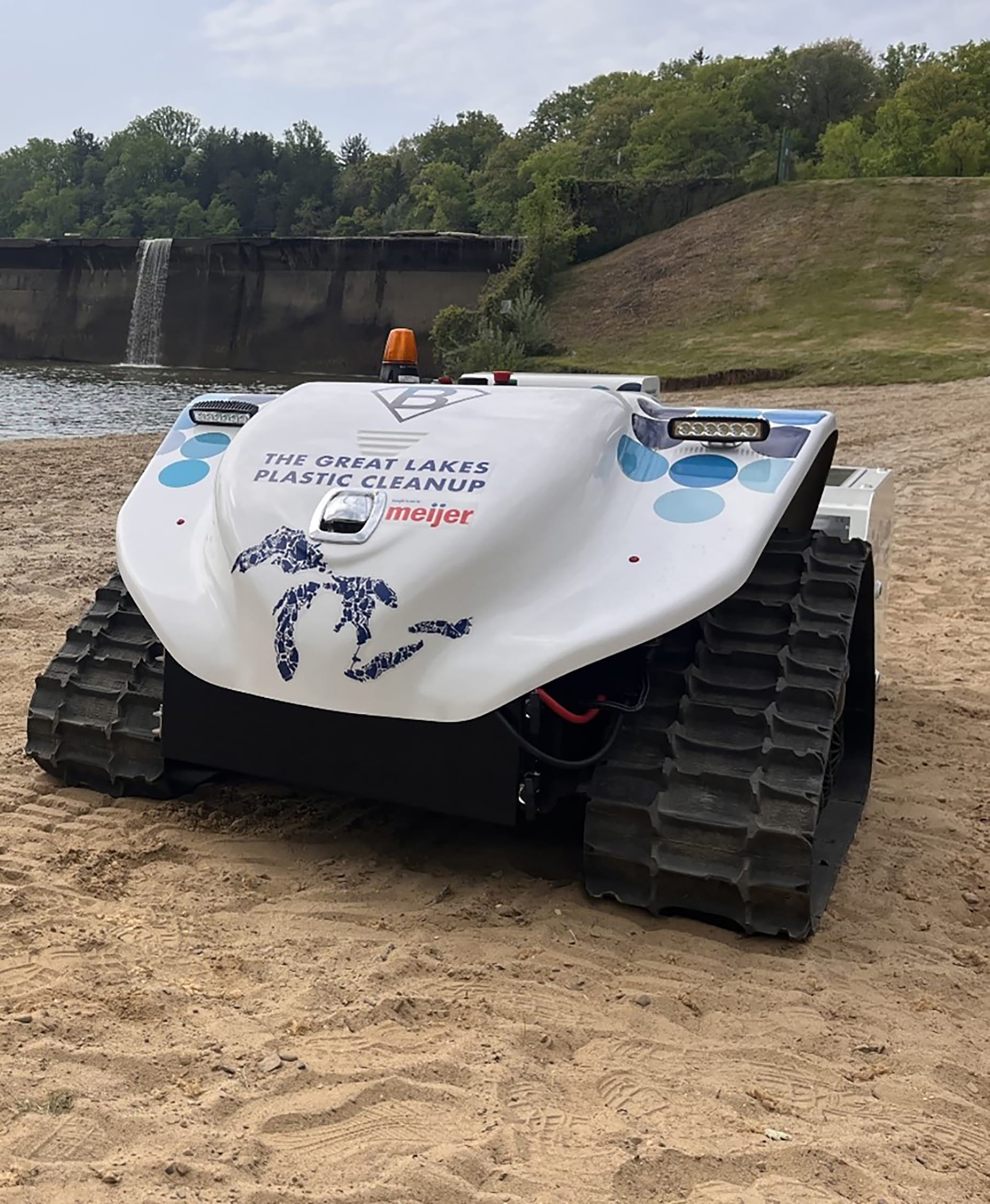Mobile robot ensures cleaner beaches across the state

Today’s MI Environmental History is provided courtesy of the Michigan Department of Natural Resources.

A beach cleaning robot called “BeBot,” an advanced trash removal method that is electrically powered and remotely controlled, is helping to keep Michigan’s inland lake beaches and the shores of the Great Lakes clean. Courtesy of the DNR.
Cigarette butts, discarded food packaging, plastic fragments – all things we want to avoid when we are at the beach with our toes in the sand.
Thanks to a new technology – a beach cleaning robot called “BeBot” developed by Niteko Robotics – we’ll see less trash on our beloved inland lake beaches and the shores of the Great Lakes. Several state park beaches now use BeBot, an advanced trash removal method that’s electrically powered and remotely controlled.
This is good news for fun summer days by the water and even better news for the environment.
With a capacity of 3,000 square meters per hour, the robot efficiently clears plastic waste of various sizes from the landscape, including bottles, food packaging, cigarette butts and broken plastic particles.
“The Michigan State Parks and Recreation System is committed to finding innovations that help us operate efficiently, save time and resources, while providing quality outdoor recreation experiences for our visitors,” said Ron Olson, chief of the Michigan Department of Natural Resources’ Division of Parks and Recreation. “This innovative tool is an opportunity to improve our methods of maintaining clean beaches.”
BeBot beach cleaning
The DNR’s Parks and Recreation Division has purchased a BeBot in 2023 for use in southeast Michigan’s Rose Lake District, which includes the Brighton Recreation Area in Livingston County.
“The BeBot is a great addition to the Rose Lake District,” said Rowdy Perry, Brighton Recreation Area Division Superintendent. “There is a lot of attention paid to the health of the Great Lakes, but the health of the inland lakes also plays an important role in protecting the state’s overall ecosystem. The BeBot not only helps clean the beaches around the district, but also serves as a talking point to educate the public about the importance of clean beaches and waters throughout the state.”
Further north, the DNR’s Gaylord District is working with the Tip of the Mitt Watershed Council to deploy a BeBot to collect trash from local beaches, including the shores of Petoskey and Cheboygan state parks.
Also this summer, the BeBot was deployed for the first time on Belle Isle, which has been managed as a state park by the DNR since 2014. This is part of the Belle Isle Conservancy’s “Keep Belle Isle Beautiful” environmental campaign and the Great Lakes Plastic Cleanup, a joint effort by the Council of the Great Lakes Region Foundation in the U.S. and the Pollution Probe in Canada aimed at improving the removal and reduction of plastic waste at Belle Isle Beach on the Detroit River.
The deployment of BeBot is a partnership between the Belle Isle Conservancy, the DNR and the CGLR Foundation and represents a significant advancement in using technology to conserve and protect our natural environment, including the international Detroit River.
“This partnership is an example of our commitment to using technology and collaboration to address environmental issues,” said Tim Slusser, director of the City of Detroit’s Office of Mobility Innovation. “By leveraging the power of BeBot, we are taking proactive steps to combat trash pollution and preserve the beauty of Belle Isle for generations to come.”
The BeBot’s arrival on Belle Isle is the result of a collaboration between the City of Detroit’s Office of Mobility Innovation and the CGLR Foundation, thanks to funding from The Clorox Company and ongoing support from Midwest retailer Meijer. With the support of the DNR, the BeBot is in action on Belle Isle Beach, where it works alongside existing cleanup initiatives by the Belle Isle Conservancy to ensure a cleaner, healthier environment for all visitors. Funding for this project was generously provided to the CGLR Foundation by The Clorox Company.
“Since 2017, the Belle Isle Conservancy has educated thousands about the dangers of single-use plastics, removed over 18,000 kilograms of plastic waste from Belle Isle and its waterways, and collaborated with local artists and designers to reuse the trash collected during our cleanups and create and exhibit visual narratives around sustainability,” said Genevieve Rattray, Director of Sustainability and Advocacy for the Belle Isle Conservancy.
“We are pleased to partner with the City of Detroit, the Michigan Department of Natural Resources and the CGLR Foundation to foster innovation and innovative technologies as we continue to protect and preserve our natural resources and take important steps toward adopting the principles, practices and policies of a circular economy.”
Mark Fisher, President and CEO of the CGLR Network, also spoke about the value of this partnership and its contribution to a Circular economy – a strategy that keeps materials and products in the loop for as long as possible by reducing material consumption, redesigning materials and products to be less resource-intensive, and recovering waste as a resource for the production of new materials and products.
“The Detroit River serves as a vital economic and environmental corridor between the United States and Canada,” Fisher said. “By partnering with the City of Detroit and the Belle Isle Conservancy, as well as The Clorox Company and Meijer, who share our commitment to sustainability in the Great Lakes region, we can keep our beaches and waterways clean and free of plastic waste as we work to end plastic waste by transitioning to a circular economy.”
Long-range robots
The BeBot, with funding from Meijer, has already proven its effectiveness in removing and studying the sources and pathways of plastic waste on Great Lakes beaches in Michigan, Ohio and Wisconsin. As cleanup efforts gain momentum in the region, the launch of the BeBot this summer on Belle Isle offers a unique and impactful solution to learn about and address the plastic waste pollution that affects not only the island and the Detroit River, but the entire Great Lakes Basin.
“Meijer is proud to support the BeBot pilot program at Belle Isle Beach, which demonstrates our commitment to environmental stewardship and innovation in the Great Lakes region,” said Erik Petrovskis, Meijer’s director of environmental and sustainability. “As a family-owned company with a long history of serving Michigan communities, we care deeply about the health and beauty of our natural resources, as well as the well-being of our customers and team members. We applaud the City of Detroit for their leadership and collaboration on this groundbreaking initiative to reduce plastic waste and protect our waterways.”
Continuation of clean-up work
The City of Detroit, the DNR and other partners will seek to secure funding in the future to expand the Belle Isle initiative to include another BeBot as well as a PixieDrone, a remote-controlled floating trash collector to be deployed in local waterways.
In addition to the BeBot pilot program, the City of Detroit remains committed to ongoing cleanup efforts, in addition to the Keep Belle Isle Beautiful campaign launched in 2017. The Belle Isle Conservancy will use the BeBot in public cleanup efforts, conduct waste analysis—determining how much paper, glass, food waste and other materials are discarded in the waste stream to create plans to reduce waste and save money and resources—and collect and report metrics from the results.



